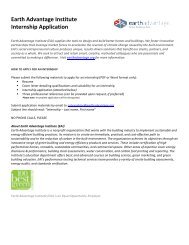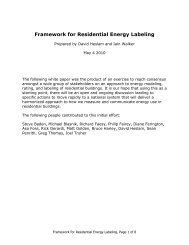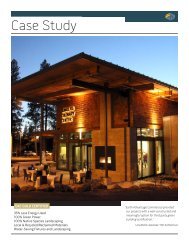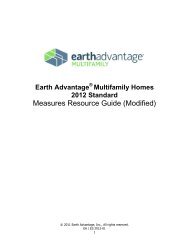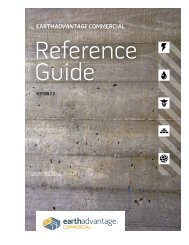EA New Homes Measures Guide - Earth Advantage
EA New Homes Measures Guide - Earth Advantage
EA New Homes Measures Guide - Earth Advantage
You also want an ePaper? Increase the reach of your titles
YUMPU automatically turns print PDFs into web optimized ePapers that Google loves.
2012 <strong>Earth</strong> <strong>Advantage</strong> Residential<br />
<strong>Measures</strong> Resource <strong>Guide</strong><br />
4.4.3<br />
Humidity Control System: Permanently installed<br />
Energy<br />
Materials<br />
Water<br />
0 1 0 1 0<br />
Description: An automatic system is installed to add or remove water vapor in order to control relative humidity levels in the home. The<br />
equipment must be permanently attached to supply or waste plumbing. Electricity may be supplied by a plug and outlet. The system must<br />
be designed to maintain the relative humity at or below 60 percent.<br />
Health<br />
Land<br />
Benefit: The optimum level for indoor relative humidity (RH) is generally considered to be between 30 percent and 50 percent. However, an<br />
occupant's specific health issues may dictate a different RH target. This system controls the humidity levels in the living space to maintain<br />
optimum humidity levels for the occupants. In humid climates lowering the humidity level minimizes the conditions conducive to the growth<br />
of a variety of molds. In dry climates adding humidity prevents the growth of certain micro-organisms and keeps skin and mucus<br />
membranes healthy.<br />
Verification: <strong>EA</strong> Rater will visually verify the presence of a dehumidifier that is attached to a drain for condensate or a humidifier that is<br />
permanently plumbed to a water supply line.<br />
4.4.4<br />
Central Vacuum: Provide rough-in for future use<br />
Energy<br />
Health<br />
Materials<br />
Water<br />
0 0 0 1 0<br />
Description: Design and install the piping for future use by a central vacuum system. Rough-in vacuum exhaust must be vented to the<br />
outside to eliminate the re-circulation of dust inside the living area.<br />
Land<br />
Benefit: Installing the ports and pipes during the construction of a home is less expensive than installing the components as a retrofit at a<br />
later date. Installing pipes in a completed house also violates the air leakage barriers installed with great care during construction. If<br />
installed during construction, central vacuum penetrations can be sealed more effectively.<br />
Verification: <strong>EA</strong> Rater will inspect for the presence of a duct to the garage or basement with outlets located at logical places within the<br />
house. For this measure, a garage or basement is considered ?inside? and the exhaust must be ducted through the wall to the exterior of<br />
the building.<br />
4.4.5<br />
Central Vacuum: Install and vent to exterior of conditioned space<br />
Energy<br />
Materials<br />
Water<br />
0 1 0 0 0<br />
Description: Central vacuum systems incorporate a motor and dust receptacle which is fixed. It is generally installed in the garage,<br />
basement, or utility room to minimize occupant exposure to motor noise and emissions. Vacuum exhaust must be vented to the outside of<br />
the home to eliminate the re-circulation of dust inside the living area.<br />
Health<br />
Land<br />
Benefit: This measure recognizes efforts to maintain good indoor air quality and a healthier living environment. Most stand-alone vacuums<br />
fail to trap much of the dust and tiny particles and simply re-circulate them into the room. Even the best vacuum cleaners cannot avoid<br />
sending some of the dirt, pollen, and other allergens back out into the room along with the exhaust. Suspended particulate can trigger<br />
asthma and other allergic reactions in occupants. By installing a central vacuum cleaner with an exhaust to the outside, dirty air is expelled<br />
from the house.<br />
Verification: Visually inspect the presence of the central vacuum motor unit and the exhaust duct to the outside. For this measure, a garage<br />
or basement is considered "inside" and the exhaust must be ducted through the wall to the exterior of the building.<br />
5 Ventilation<br />
5.1 General Ventilation<br />
Page 39 of 70



